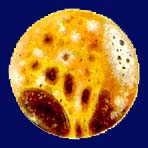Ganymede:
A Wrinkle in Jupiter's system
- Jupiter's largest satellite.
- Largest moon and 8th largest body in Solar System
- Average distance from Jupiter is 1,070,400 km.
- Revolution is 7 days 3 hours.
- Diamter is 5,280 km
- Composed of ice and carbonaceous silicates.
- One face pointing toward planet (synchronous).
- View from Earthbound telescopes is as a pinhead with vague markings.
- Geology of this ice-dominated moon revealed by Voyagers 1 & @ in 1979.
- Ice and water assume geologic roles similar to Earth's rock and lava.
- A "magma" of watery materiall erupts from internal heat.
- WHen the "magma" freezes, the fresh surface appears as bright ice.
- Dark with heavily cratered areas, grooved terrain and a system of faults.
- Mean density higher than density of pure ice.
- Density lower than most rock types.
- Indicative of a rock component, but not pure rock or ice.
- Most rock has probably shifted toward the moon's center.
- Core is likely to be rocky with an ice mantle.
- Earthbound scientists expected Voyager probes to reveal and ancient static surface pocked with impact craters.
- Ganymede does have large regions of ancient craters.
- Crater regions broken by swaths of young furrows.
- Younger formations believed to be youthful flows and ice squeeze-ups.
- Older terrain is dark, suggesting that the ice component has been vaporized by meteor impact.
- Giant arcs of parallel furrows cross the cratered surface.
- Furrows are few kilometers wide and hundreds of kilometers long.
- Appear to be fragments of giant, ancient impact craters.
- Known as "multi-ring" basins, created by the largest impacts.
- Such impacts leave behind multiple concentric rings of cliffs hundreds of kilometers across.
- Resemble a bull-eye of a target.
- Similar, more complete, multi-ring systems appear on
Mercury, our Moon
and Callisto.
- Ganymede's surface resembles a giant jigsaw puzzle.
- Ancient craters have been broken or shifted by resurfacing processes.
- Most of the original picture is preserved.
- Some parts replaced by swaths of fresher ice.
- Newer regions appear as lighter, wandering bands among dark polygonal regions of craters.
- Lighter regions traverse by intricate systems of narrow fissures.
- Narrow fissures arranged as parallel streaks, in turn broken by craters.
- Appearance of surface pattern suggestive of an original dark crust.
- This crust appears to have been broken apart by expansion.
- Ganymede's equivalent of lava, water, was allowed to flow onto the surface.
- The water then froze into ice floes.
- Further eruptions along fissures squeezed out new parallel ridges of ice.
- The same phenomenon also occurs in Earth's Acrtic ice floes.
- Ganymede displays the process of plate tectonics, not as dynamic as on Earth.
- Ganymede's interior may be warm, but not as hot as Earth's.
- The ice "lithosphere" at the surface may have broken into "plates," but the plates have only jostled one another.
- Little scattered pieces hseem to have moved tens of kilometers, offsetting craters and faults.
- No large-scale motions or collisions and no folded mountain ranges like the ones found on Earth.
- Other interesting features of Ganymede:
- Whitish polar caps extend down to latitudes about 40 degrees.
- Caps may mark condensation of water vapor escaping from fractures around the planet.
- Most fresh craters display bright radiating rays of ejecta blown onto the surrounding surface.
- These craters probably blew away the darkish surface soil to expose fresher ice.
- Occasional small craters, typically 10 to 20 kilometers (6 to 12 miles) across and a few kilometers deep, have dark rays.
- Small craters may reflect a layered structure beneath Ganymede's surface.
- Should surface layers melt or if "volcanic water" gushes out along with soil, the soil would sink before the resulting oceans froze.
- Therefore craters need penetrate a few kilometers to tap layers of blackish soil.
- Ganymede's surface may contain intricate sedimentary layers of ice and rock.
- Ganymede provides a simple model in which ice, one of the prime geologic constituents, interacts with rocky material.
- Remnants of cratered "plates," partially erased by fractures and ice flows, testify to the forces that shape all worlds.
|



